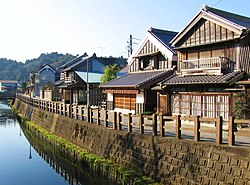Sawara, Chiba
|
Sawara 佐原市 |
|
|---|---|
| Former municipality | |

Sawara canal and historical district
|
|
 Location of Sawara in Chiba Prefecture |
|
| Location in Japan | |
| Coordinates: 35°52′59″N 140°30′00″E / 35.883°N 140.500°ECoordinates: 35°52′59″N 140°30′00″E / 35.883°N 140.500°E | |
| Country | Japan |
| Region | Kantō |
| Prefecture | Chiba Prefecture |
| District | Katori |
| Merged | March 27, 2006 (now part of Katori) |
| Area | |
| • Total | 119.88 km2 (46.29 sq mi) |
| Population (February 1, 2005) | |
| • Total | 47,244 |
| • Density | 394/km2 (1,020/sq mi) |
| Symbols | |
| • Tree | Populus |
| • Flower | Siberian Iris |
| Time zone | Japan Standard Time (UTC+9) |
Sawara (佐原市 Sawara-shi?) was a city located in Katori District, Chiba Prefecture, Japan.
Sawara has been settled since prehistoric times, and has numerous remains of Jōmon period shell middens and Kofun period burial mounds. By the Nara period, it had developed as a port, and as a monzenmachi associated with Katori Shrine, and in the Heian period was a regional commerce center for numerous shōen in the area. During the Edo period, it was partly under the control of the Omigawa Domain, a feudal domain of the Tokugawa shogunate. Modern Sawara Town was created in 1898 and raised to city status on March 15, 1951 through merger with neighboring town of Katori and the villages of Kasai and Higashi-Oto. It expanded further on February 11, 1955 through annexation of the neighboring villages of Mizuho, Shinshima, Tsunomiya and Okura. In March 1996, Sawara established sister city relations with Nanjing in China.
On March 27, 2006, Sawara, along with the towns of Kurimoyo, Omigawa and Yamada (all from Katori District), was merged to create the city of Katori, and thus no longer exists as an independent municipality.
...
Wikipedia

